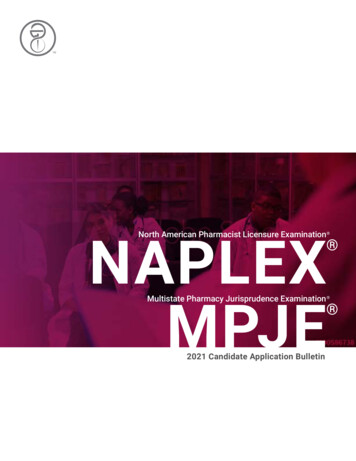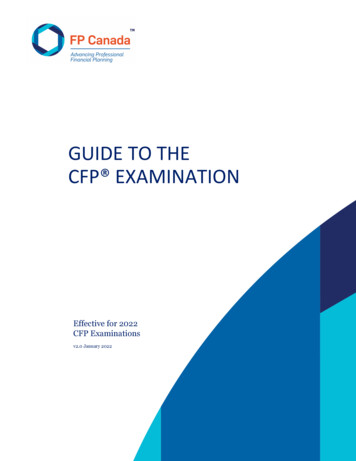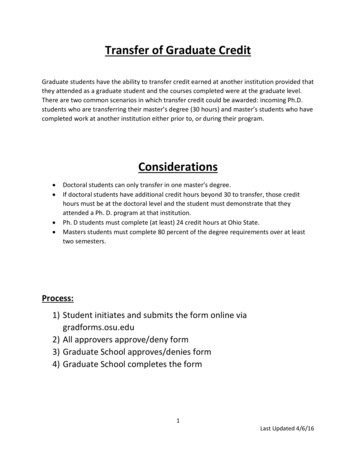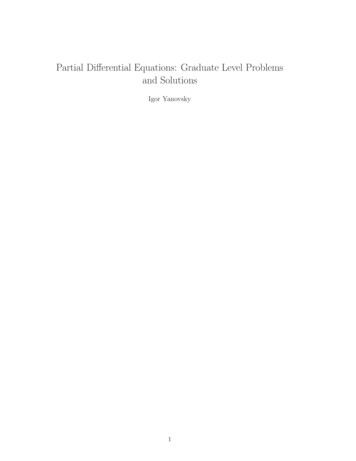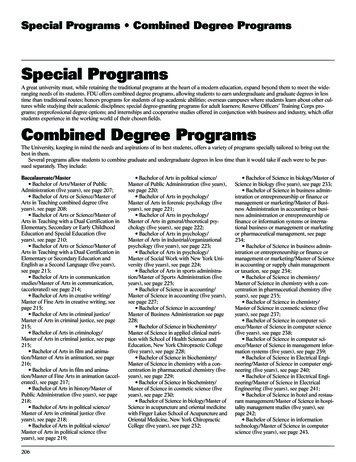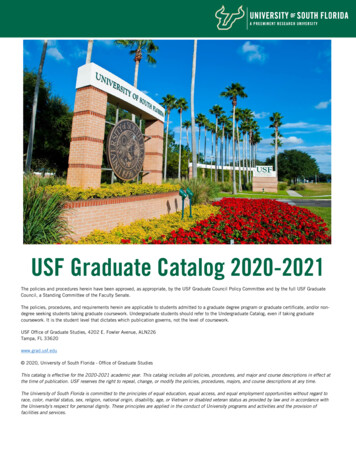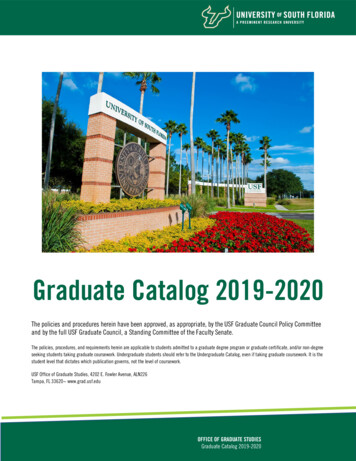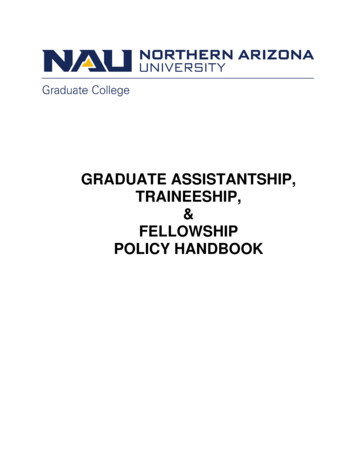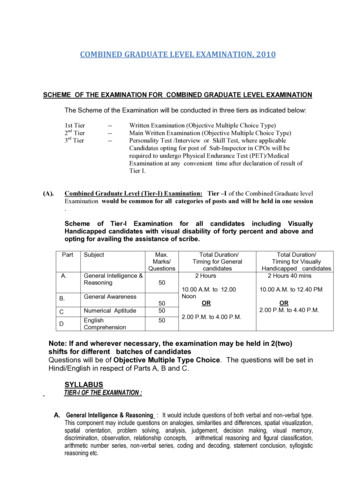
Transcription
COMBINED GRADUATE LEVEL EXAMINATION, 2010SCHEME OF THE EXAMINATION FOR COMBINED GRADUATE LEVEL EXAMINATIONThe Scheme of the Examination will be conducted in three tiers as indicated below:1st Tier2nd Tier3rd Tier----Written Examination (Objective Multiple Choice Type)Main Written Examination (Objective Multiple Choice Type)Personality Test /Interview or Skill Test, where applicableCandidates opting for post of Sub-Inspector in CPOs will berequired to undergo Physical Endurance Test (PET)/MedicalExamination at any convenient time after declaration of result ofTier I.Combined Graduate Level (Tier-I) Examination: Tier –I of the Combined Graduate levelExamination would be common for all categories of posts and will be held in one session.(A).Scheme of Tier-I Examination for all candidates including VisuallyHandicapped candidates with visual disability of forty percent and above andopting for availing the assistance of scribe.PartSubjectA.General Intelligence &ReasoningB.General AwarenessCNumerical tal Duration/Timing for Generalcandidates2 HoursTotal Duration/Timing for VisuallyHandicapped candidates2 Hours 40 mins5050505010.00 A.M. to 12.00NoonOR10.00 A.M. to 12.40 PMOR2.00 P.M. to 4.40 P.M.2.00 P.M. to 4.00 P.M.Note: If and wherever necessary, the examination may be held in 2(two)shifts for different batches of candidatesQuestions will be of Objective Multiple Type Choice. The questions will be set inHindi/English in respect of Parts A, B and C.SYLLABUSTIER-I OF THE EXAMNATION :A. General Intelligence & Reasoning : It would include questions of both verbal and non-verbal type.This component may include questions on analogies, similarities and differences, spatial visualization,spatial orientation, problem solving, analysis, judgement, decision making, visual memory,discrimination, observation, relationship concepts, arithmetical reasoning and figural classification,arithmetic number series, non-verbal series, coding and decoding, statement conclusion, syllogisticreasoning etc.
B. General Awareness : Questions in this component will be aimed at testing the candidates generalawareness of the environment around him and its application to society. Questions will also bedesigned to test knowledge of current events and of such matters of every day observations andexperience in their scientific aspect as may be expected of any educated person. The test will alsoinclude questions relating to India and its neighbouring countries especially pertaining to sports, History,Culture, Geography, Economic Scene, General Polity, Indian Constitution, scientific Research etc.These Questions will be such that they do not require a special study of any discipline.C.Numerical Aptitute : The questions will be designed to test the ability of appropriate use of numbersand number sense of the candidate. The scope of the test will be the computation of whole numbers,decimals and fractions and relationships between numbers. It will test sense of order among numbers,ability to translate from one name to another, sense or order of magnitude, estimation or prediction ofthe outcome of computation, selection of an appropriate operation for the solution of real life problemsand knowledge of alternative computation procedures to find answers. The questions would also bebased on arithmetical concepts and relationship between numbers and not on complicated arithmeticalcomputation (The standard of the questions will be of 10 2 level).D.English Comprehension : Candidates’ ability to understand correct English, his basic comprehensionand writing ability, etc. would be tested.(The questions in the components A,B & D will be of a level commensurateQualification prescribed for the post viz; graduation).(B).with the EssentialScheme of Examination for Combined Graduate Level (Tier-II)Examination:Tier-II of the Combined Graduate Level Examination -2010will be ofObjective Type Multiple Choice and will be conducted over two days during aweekend. It will consist of three different papers/subjects and depending upon the categoryof posts applied for, the candidate will be required to appear in one, two or three papers, asthe case may be.FOR THE POST OF ASSISTANTS, INSPECTOR OF INCOME-TAX/INSPECTOR(CENTRAL EXCISE,INSPECTOR(PO), INSPECTOR(EXAMINER) SUB INSPECTOR INCBI, INSPECTOR OF POSTS, ASSISTANT ENFORCEMENT OFFICER, DIVISIONALACCOUNTANTS,ACCOUNTANTS, AUDITORS, TAX ASSISTANTS, UDCs,THEEXAMINATION WILL CONSIST OF TWO PAPERS AS UNDER:Paper Subject /No.PaperIIIArithmeticalAbilityEnglishLanguage 200Duration & Timings Duration & Timingsfor Generalfor VH candidatescandidates2Hours10.00 AM to 12.00PM2 Hours and 40 Min.10.00 AM to 12.40PM2 Hours2.00 PM to 4.00 PM2 Hours. and 40 Min.2.00 PM to 4.40 PM
FOR THE POST OF STATISTICAL INVESTIGATORS GR.II & COMPILERS, THEEXAMINATION WILL CONSIST OF THREE PAPERS AS UNDER:PaperNo.Subject / PaperIArithmetical sh Language onomics200(200Duration & Timings forGeneral candidatesDuration & Timingsfor VH candidates2Hours10.00 AM to 12.00 PM2 Hours and 40 Min.10.00 AM to 12.40 PM2 Hours2.00 PM to 4.00 PM2 Hours. and 40 Min.2.00 PM to 4.40 PM2 Hours2.00 PM to 4.00 PM2 Hours. and 40 Min.2.00 PM to 4.40 PMQuestions )200(200Questions )For the post of Sub-Inspector in Central Police Organisations, the Examination will consistof o one paper as under:PaperNo.Subject / PaperIEnglish Language Duration & Timings forGeneral candidates2Hours2.00 PM to 4.00 PMNOTE :1. The Commission will have the full discretion to fix separate minimum qualifyingmarks in each of the papers and in the aggregate of all the papers separately foreach category of candidates (viz. SC/ST/OBC/PH/ExS/General (UR) ). Onlythose candidates who qualify in all the papers as well as in the aggregatewould be eligible to be considered for being called for the Personality Test/Interview and/or Skill Test.2. There will be different set of Questions for the papers on Arithmetic &General Studies for Visually Handicapped (VH) candidates which shall agrams/Figures/Geometrical problems/Pie-chart etc.However,components of other papers will be the same as that for general candidates.SYLLABUSTIER-II OF THE EXAMNATION :
Paper-I : Arithmetic Ability : This paper will include questions on problems relating to Number Systems,Computation of Whole Numbers, Decimals and Fractions and relationship between Numbers,Fundamental Arithmetical Operations, Percentage, Ratio and Proportion, Average, Interest, Profit andLoss, Discount, Use of Table and Graphs, Mensuration, Time and Distance, Ratio and Time etc.Paper-II : English Language & Comprehension :Questions in this components will be designed to test thecandidate’s understanding and knowledge of English Language and will be based on errorrecognition, fill in the blanks (using verbs, preposition, articles etc), Vocabulary, Spellings, Grammar,Sentence Structure, Synonyms, Antonyms, Sentence Completion, Phrases and Idiomatic use ofWords, etc. There will be a question on passages and omprehension of passages also. (The standardof the questions will be of 10 2 level).Paper-III : Commerce/Mathematics/Statistics/Economics for Investigator Grade-II, for Ministry of Statistics &Programme Implementation and Compiler for Registrar General of India, Ministry of Home Affairs. (?)A. STATISTICSProbability, Probability Distributions, Binomial, Poisson, Normal, Exponential.Compilation, classification, tabulation of Statistical Data, Graphical presentation of data.Measures of central tendency, measures of dispersion, measures of association and contingency, scatterdiagram, correlation coefficient, rank correlation coefficient and linear regression analysis ( for two or morevariables ) excluding partial correlation coefficients.Concept of Population, random sample, parameters, statistics, sampling distribution ofestimators and estimation of confidence intervals.x properties ofPrinciples of sampling, simple random sampling, stratified sampling, systematic sampling etc., Sampling andnon-sampling errors, type-I and type-II errors.Concepts of Hypothesis – Null and alternate, Testing of hypothesis for large samples as well as smallsamples including Chi-square tests ( Z, t, F, 2 tests ).Index Numbers, Time series analysis – components of variation and their estimation.B. ECONOMICSGENERAL ECONOMICS1.Demand and Supply Analysis, including Laws and Interaction of Demand and Supply.2.Production Function and Laws of Returns.3.Commodity Pricing – Characteristics of various Market Forms and Price Determination under suchMarket Forms.4.Theory of Factor Pricing – Rent, Wage, Interest and Profit.5.Theory of Employment – Classical and Neo-classical Approach.6.Keynesian Theory of Employment – Principles of Effective Demand. Meaning and Importance ofInvestment, Relation between Saving and Investment, Multiplier Effect and the process of IncomeGeneration, Post Keynesian Development.7.Nature and Functions of Money, Value of Money, Fluctuations in the value of Money – Inflation andDeflation, Monetary Policy, Index Number.
8.9.10.11.12.13.International Trade-Free Trade and Protection, Theories of International Trade.Foreign Exchange – Determination of the rate of Exchange – Purchasing Power Parity theory andBalance of Payment Theory.Public Finance – Nature. Scope and importance of Public Finance.Taxation – Meaning, Classification and Principles of Taxation, Incidence of Taxation.Deficit Financing.Fiscal Policy.INDIAN ECONOMICS AND GENERAL ical Investigation – Meaning and Planning of Investigation.Collection of data and editing of data.Types of sampling.Schedule and questionnaire.Presentation of data – classification, tabulation, etc.Measures of Central Tendency.National Income and Accounting – Estimation of National Income, Trends in National Income,Structural changes in the Indian Economy as seen in National Income Data.Agricultural sector – Agricultural Development during Plan Period, Rural Credit, Agricultural PricePolicy, Rural Development Co-operation and Panchayati Raj.Industrial Policy and Industrial Development.Problems of Economic Development – Indian Planning – Objectives, Techniques and its evolution, FiveYear Plans and Role of National Development Council.Profile of Human Resources – Population and Economic Development, Demographic Profile of India,Nature of Population Problem – Poverty, Inequality, Unemployment Problem, Labour Problem,Population Control and Government Policy.New Economic Policy and Welfare Schemes.Indian Public Finance – Indian Revenue, Foreign Aid.Indian Banking and Currency system.C. MATHEMATICSAlgebra:Algebra of sets, relations and functions, Inverse of a function, equivalence relation.The systemof complex numbers, De Moivere’s Theorem and its simple applications. Relation between roots and coefficients of a polynomial equation – Evaluation of symmetric function of roots of cubic and biquadratic equation.Algebra of Matrices: Determinants, Simple properties of determinants, Multiplication of determinants of orderstwo and three, Singular and non-singular matrices. Inverse of a matrix, Rank of a matrix and application ofmatrices to the solution of linear equations ( in three unknowns ).Convergence of sequences, and series, tests of convergence of series with positive terms,Ratio, Root and Gauss tests.Analytic Geometry: Straight lines, Circles, System of circles, parabola, ellipse and hyperbola in standard formand their elementary properties, Classification of curves second degree.Differential Equation: First order differential equation. Solution of Second and higher order linear differentialequations with constant coefficients and simple applications.Differential and Integral Calculus: Limit, continuity and differentiability of functions, successive differentiation,derivatives of standard functions, Rolle’s and Mean-value Theorems, Maclaurins and Taylor’s series ( withoutproof) and their applications, Maxima and Minima of functions of one and two variables. Tangents and Normals,Curvature, Partial differentiation, Euler’s theorem for homogeneous function, Tracing of curves.
Standard methods of integration, Riemann’s definition of definite integral, fundamental theorem ofintegral calculus, quadrature, rectification, volumes and surface area of solids of revolution.Statistics:Frequency distributions, Measures of central tendency, measures of dispersion, Skewness andKurtosis, Random variables and distribution function, Discrete distributions, Binomial and Poisson distribution,continuous distributions, Rectangular, Normal and Exponential distributions, Principles of least squares,correlation and regression, Random Sampling, random numbers, Sampling of attributes, Large Sample tests formean and proportion, Tests of significance based on t, F and Chi-square distributions.D. COMMERCEThis paper will cover all the subjects of commerce ordinarily taught at the B.Com. or similar degree courses ofIndian Universities. Specifically, it will include the following subjects:Accountancy: Conceptual framework, Income measurement, Final accounts, Accounting for partnership firms,Hire-purchase accounting, Corporate accounting( Issue, forfeiture and re-issue of shares ).Business Organisation: Business objectives, Business environment, Business entrepreneurship ( includinglocation, choice of form of business and growth strategies ),Business operations including finance, production, marketing and human resource development.Management: Concept of management, Planning, Organising, Leading and Controlling.Micro-economics:Price-mechanism, Theory of consumer behaviour, Elasticity of demand, Productionfunction, Theory of costs, Market structures, Price-determination under perfect competition and monopoly.Indian Economics:Issues involved in planning for economic development, Sectoral analysis of Indianeconomy including agriculture, industry and foreign trade.Business Statistics:Analysis of Univariate data involving measurement of Central tendency anddispersion, correlation and regression analysis, index numbers, analysis of time-series, Theory of probability.Business Law: Indian Contract Act, 1872, Sale of Goods Act, 1930, Partnership Act, 1932 and NegotiableInstruments Act, 1881.Company Law: Kinds of companies, matters involving incorporation of company, shares and share capital andmatters relating to issue and transfers of shares, members of a company, management of a company, meetingsand resolutions, winding up of a company.Cost accounting: Procedures involved in cost accounting, marginal costing, cost-volume profit analysis,Budgetary control, Standard costing.Auditing: Meaning and objects of auditing, Types of audit, Audit process.Income Tax:Basic concepts, Residence and tax liability, heads of income. .NOTE - 1: In Numerical Aptitude paper for Visually Handicapped candidatesof 40% and above visual disability and opting for SCRIBE there will rams/Figures/Geometrical problems.NOTE - 2: The Commission shall have the discretion to fix different minimumqualifying standards in each subject of the Tier-I Examination taking intoconsideration among others, category-wise vacancies and category-wisenumber of candidates. Only those candidates, who have scored above the
cut off marks fixed by the Commission would be required to appear in theTier –II Examination.NOTE:3 Tier-I will be used to screen the candidates for appearing in Tier-II for variouspapers which will be specifically required for different groups of posts. However,marks of such screened candidates in Tier-I will be taken into account for finalranking of candidates for selecting them for the interview and also final selection.
8. International Trade-Free Trade and Protection, Theories of International Trade. 9. Foreign Exchange – Determination of the rate of Exchange – Purchasing Power Parity theory and Balance of Payment Theory. 10. Public Fina

